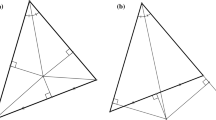Abstract
Bonaventura Cavalieri has been the subject of numerous scholarly publications. Recent students of Cavalieri have placed his geometry of indivisibles in the context of early modern mathematics, emphasizing the role of new geometrical objects, such as, for example, linear and plane indivisibles. In this paper, I will complement this recent trend by focusing on how Cavalieri manipulates geometrical objects. In particular, I will investigate one fundamental activity, namely, superposition of geometrical objects. In Cavalieri’s practice, superposition is a means of both manipulating geometrical objects and drawing inferences. Finally, I will suggest that an integrated approach, namely, one which strives to understand both objects and activities, can illuminate the history of mathematics.
Similar content being viewed by others
References
Agazzi E. (1967) La ricomparsa di Bonaventura Cavalieri. Periodico di Matematiche 45: 1–11
Agostini Amedeo (1940) I baricentri di gravi non omogenei e la formola generale per il loro calcolo determinati da Bonaventura Cavalieri. Bollettino dell’ Unione Matematica Italiana, 2(d series 2): 147–171
Andersen K. (1985) Cavalieri’s method of indivisibles. Archive for the History of Exact Sciences 31: 291–367
(1544) Archimedis Syracusani Philosophi ac Geometrae Excellentissimi Opera. Ioannes Hervagius, Basel
(1558) Opera nonnulla (Federico Commandino, Ed). Paulus Manutius, Venice
(1615) Opera quae extant(David Rivault, Ed). Apud Claudium Morellum, Paris
Archimedes, 1880. Opera omnia, Vol. I., (I. L. Heiberg, Ed.). Teubner, Leipzig.
Archimedes, 1974. Opere di Archimede (Attilio Frajese, Ed.). UTET, Turin.
Arrighi G. (1973) La ‘Geometria indivisibilibus continuorum’ di Bonaventura Cavalieri nella ritrovata stesura del 1627. Physis 15: 133–147
Beeley P. (1996) Kontinuität und Mechanismus. Zur Philosophie des jungen Leibniz in ihrem ideengeschichtlichen Kontext. Stuttgart, Steiner
Cavalieri Bonaventura (1635) Geometria indivisibilibus continuorum nova quadam ratione promota. Clemente Ferroni, Bologna
Cavalieri Bonaventura (1647) Exercitationes geometricae sex. Giacomo Monti, Bologna
Cavalieri, Bonaventura, 1966. Geometria degli indivisibili (L. Lombardo-Radice, Ed. and Tr.). UTET, Turin.
Cellini G. (1966) Le dimostrazioni di Cavalieri del suo principio. Periodico di Matematiche 44: 85–105
(1966b) Gli indivisibili nel pensiero matematico e filosofico di Bonaventura Cavalieri. Periodico di Matematiche 44: 1–21
Clavius, Christoph, 1999. Commentaria in Euclidis Elementa Geometrica. Olms-Weidmann, Hildesheim [facsimile edition of part of the first volume of Christophori Clauii Bambergensis e Societate Iesu Opera mathematica V tomis distributa (1611–1612). Sumptibus Antonij Hierat excudebat Reinhard Eltz, Mainz].
De Gandt, F. 1992. Cavalieri’s indivisibles and Euclid’s canons. In: Revolution and continuity: Essays in the history and philosophy of early modern science (P. Barker, R. Arew, Eds.), Washington, DC., The Catholic University of America Press, pp. 157–182.
Euclid, 1557. In Euclidis elementa geometrica demonstrationum libri sex (Jacques Peletier, Ed.). Apud Tornaesium and Gazeium, Lyon.
Euclid, 1575. De gli Elementi d’ Euclide libri quindici (Federico Commandino, Ed.). Frisolino, Urbino.
Euclid, 1883. Opera omnia, vol. I, (I. L. Heiberg, H. Menge, Eds.). Teubner, Leipzig.
Euclid, 1884. Opera omnia, vol. II, (I. L. Heiberg, H. Menge, Eds.). Teubner, Leipzig.
Euclid, 1956. The Thirteen Books of the Elements.Translated with introduction and commentary by Sir Thomas Heath. 3 vols. 2nd edition. New York: Dover Publications.
Favaro A. (1885) Bonaventura Cavalieri nello Studio di Bologna. Fava e Garagnani, Bologna
Festa E. (1992) La notion d’ ‘aggrégat d’ indivisibles’ dans la constitution de la cinématique galiléenne: Cavalieri, Galilée, Torricelli. Revues d’ histoire des sciences 45: 307–336
Giuntini, S., 1985, [Ed.]. De spatijs helicis (Il trattatello delle spirali). Bollettino di storia delle scienze matematiche 5, 7–36.
Giusti E. (1980) Bonaventura Cavalieri and the theory of indivisibles. Edizioni Cremonese, Rome
Guldin, Paulus, 1635. De centro gravitatis, Vol. I. Formis G. Gelbhaar, Vienna.
Guldin, Paulus, 1640–2641. De centro gravitatis, Vols. II-IV. Formis Matthaei Cosmerovii, Vienna.
Koyré, A., 1973. Bonaventura Cavalieri et la géométrie des continus. In: Koyré, A., Études d’ histoire de la pensée scientifique. Gallimard, Paris [1st edition, Presses Universitaires de France, Paris], pp. 334–361.
Malet, A., 1996. From indivisibles to infinitesimals. Universitat Autònoma de Barcelona, Bellaterra (Barcelona).
Mancosu Paolo (1996) Philosophy of mathematics and mathematical practice in the seventeenth century. Oxford University Press, New York and Oxford
Mueller, Ian, 2006. Philosophy off mathematics and deductive structure in Euclid’s Elements. New York: Dover Publications (1st ed. Cambridge, MA: MIT Press).
Muntersbjorn, M., 2000. The qauadrature of parabolic segments 1635–2658: A response to Herbert Breger. In: The growth of mathematical knowledge (E. Grosholz, H. Breger, Eds.). Kluwer Academic Press, Dordrecht/ Boston/ London, pp. 229–256.
Piola Gabrio (1844) Elogio di Bonaventura Cavalieri. Bernardoni Di Giovanni, Milan
Proclus, 1560. In primum Euclidis elementorum librum (Francesco Barozzi, Ed.). Perchacinus, Padua.
Sestini, G., 1996/97. La ‘Geometria indivisibilibus’ di Bonaventura Cavalieri nelle edizioni manoscritte del 1627.Annali della facoltà di Lettere e Filosofia. 4. Studi Filosofici. Vol. 34, n. 20. Università degli Studi di Perugia, Perugia, pp. 85–119.
Struik D.J. (1969) A source book in mathematics, 1200-1800. Harvard University Press, Cambridge, MA
Terregino G. (1980) Sul principio di Cavalieri. Archimede 32: 59–65
Terregino G. (1987) La seconda ‘ratio’ di Bonaventura Cavalieri. Archimede 39: 209–213
Torricelli, Evangelista, (1919–2944). Opere (G. Loria, G. Vassura, Eds.), 4 vols. G. Montanari, Faenza.
Vita V. (1972) Gli indivisibili curvi in Bonaventura Cavalieri. Archimede 24: 16–24
Author information
Authors and Affiliations
Corresponding author
Additional information
Communicated by U. Bottazzini.
Rights and permissions
About this article
Cite this article
Palmieri, P. Superposition: on Cavalieri’s practice of mathematics. Arch. Hist. Exact Sci. 63, 471–495 (2009). https://doi.org/10.1007/s00407-008-0032-z
Received:
Published:
Issue Date:
DOI: https://doi.org/10.1007/s00407-008-0032-z




